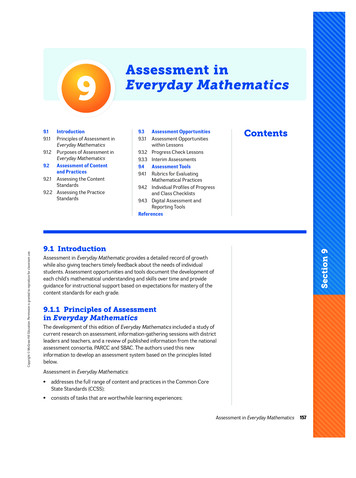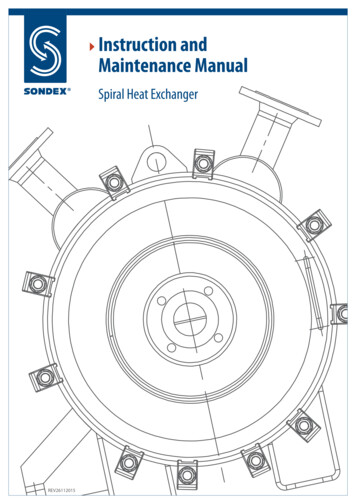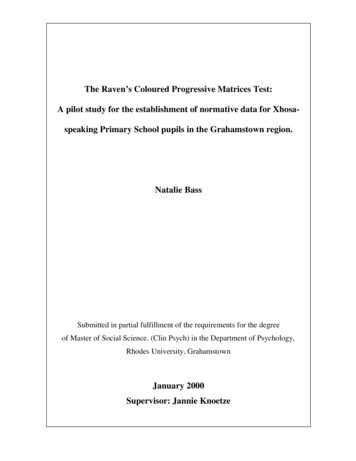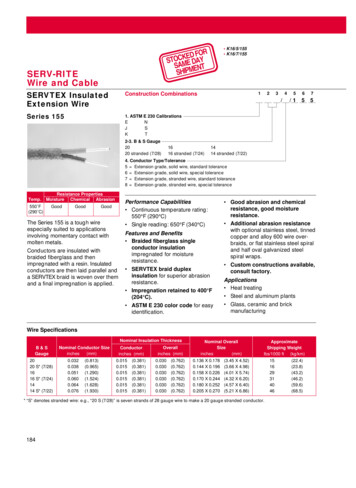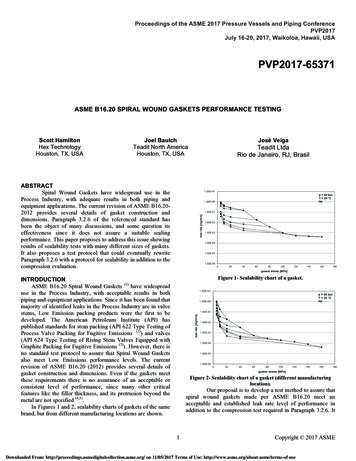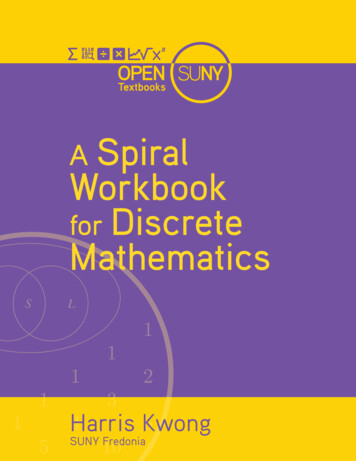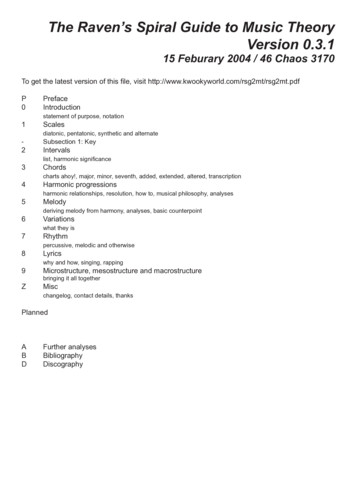
Transcription
The Raven’s Spiral Guide to Music TheoryVersion 0.3.115 Feburary 2004 / 46 Chaos 3170To get the latest version of this file, visit 456789ZPrefaceIntroductionstatement of purpose, notationScalesdiatonic, pentatonic, synthetic and alternateSubsection 1: KeyIntervalslist, harmonic significanceChordscharts ahoy!, major, minor, seventh, added, extended, altered, transcriptionHarmonic progressionsharmonic relationships, resolution, how to, musical philosophy, analysesMelodyderiving melody from harmony, analyses, basic counterpointVariationswhat they isRhythmpercussive, melodic and otherwiseLyricswhy and how, singing, rappingMicrostructure, mesostructure and macrostructurebringing it all togetherMiscchangelog, contact details, thanksPlannedABDFurther analysesBibliographyDiscography
PrefaceG’day! This is Simon from the Raven’s Spiral.You have in your possession the Raven’s Spiral Guide to Music Theory, or RSG2MT for short. Ugly abbreviationsaside, this book will aim to teach you a thing or two about music theory without boring the arsehairs clean off you. It’sbeen used as both an introductory primer and a refresher course for people like me who survived on a tiny wee smattering of music theory for ages without really having had a lot of cause to think about it.The software I use to write my music is freeware, so the way I see it there ought to be a free guide to writing music inthis day and age too. It will always be freely available on the Internet in one location or another.Before i started writing this book, i hadn’t found any really useful free resources online that teach about music theory.I’ve got the knowledge and the time to write a guide which is tantamount to spending a semester or two in a musictheory class, so i’m putting my effort into compiling a small tome of info for those who want to learn.Over time, this book is going to cover everything that an amateur composer ought to know to enrich their compositional capabilities: harmony, melody, rhythm and structure are all covered in various amounts of detail. It’s not intendedas a be all and end all guide--much of the material isn’t explained with the amount of depth you’d get in a proper bookyou can buy from a store. That said, those books are usually expensive and require you to know how to read music.Yes, they will helpfully teach you how to read sheet notation, but you’ll be pleased to know that i’m not going to forcethe issue at all.That’s right: you don’t have to be able to read music to use this guide. It will serve you no advantage at all to be ableto do so. I hate that so many theory books shut home musicians out that way.What you will need handy is a keyboard instrument of some sort like a piano or synthesiser, or at least something tomake music on. The examples are all keyboard-based, and given that my audience is primarily made up of peoplewho use computers and that the most common explicitly musical interface to computers is the good old piano keyboard, this isn’t a random choice.[Stick short biography here]The following material is Copyright (C) 2002-2004 Simon Bennett. It is an acknowledged work in progress. This guidemay be freely distributed in an electronic form as long as it is unaltered. It may be printed by individuals for privateuse. Publishing in print media or alteration/copying of the contents of this file is explicitly prohibited except with theconsent of the original author, and furthermore is very uncool.
0.0 Basic notations and other starting points0.1 Content and purposeThe stated purpose of this guide is to help composers without an academic background like me learn the basics ofmusic theory. I don’t feel a great need to explain how it is that people can start writing music without knowing at allabout music theory, because chances are if you’re reading this guide that’s exactly what you’ve done.There are much better books out there on the topic than the one i’m planning to write, but the main difference will bethat this one will be free of charge to anyone with an Internet connection. This is how it should be in this day and agewhere free software is available to anyone who wants it but the secrets of composing music are hidden away in prohibitively expensive books about composition and so on, often forcing the reader to figure out things like sheet notation and do a heap of boring exercises at the end of each chapter.Personally, i don’t like those books too much, myself. The book I’m writing here is one for the sort of person whowants a vague groundwork of rules to give them structure which they can then bend and twist to their will. They want away to write down their ideas and are curious to see how the chords they jam out relate to one another. They want tobranch out and experiment with elements of music they don’t know much about.And they want to do this with the least effort and stress required. That’s what this book is about and who it’s for. It’s notfor seasoned musicians at all. A lot of it is likely to be totally inconsistent with wider music theory, for which i make noapologies whatsoever. It’s also written to be a bit colloquial and fun instead of being completely straightforward.I see a need for this information and knowledge to be liberated for the good of all humankind, and i’m putting my effortwhere my mouth is.Now, this book is laid out in chapters in order to group knowledge into sections like chords, rhythm, lyrics, melody, andall that kind of thing. This is not a proclamation that music is essentially melodic, not in the slightest, nor is it a proclamation that music must be composed in this order. It’s a sacrifice to simple linearity.0.2 NotationsOne sort of notation i’m going to use should be immediately familiar, the other perhaps not so. There will also be somejargony words involved, but i’ll explain them along the way. First off, the notes:0.2.1: Real notationDb EbC# D#Gb Ab BbF# G# A#Db EbC# D#Gb Ab BbF# G# A#C D E F G A B C D E F G A B CHere’s a diagram of which notes are which—should you need it, of course.Between C and C# is the distance of one semitone, because C# is one note away from C. Between C and D there is adistance of one whole tone because C is two notes away from D (counting C# of course). Between E and F, however,there is the distance of a single semitone, not a whole tone, and the same goes between B and C. From D# to F is thedistance of one whole tone, because between D# and F is E.From D to F is three semitones. From C to E is four semitones. From C to G is seven semitones. From C to the Cabove is twelve semitones.The above knowledge is pretty fundamental and i’ll be using them to teach you about other things like scales, so besure you know what semitones and whole tones are before continuing.
Sharps and flats are the next port of call. C# is one semitone up from C. If you sharpen C, therefore, it becomes C#(pronounced C sharp). Db is one semitone down from D. If you flatten D, you end up with Db (pronounced D flat). Soin music, to to sharpen something is to raise it by a semitone, and to flatten it is to lower it by a semitone.The next word you should learn from this diagram is enharmonic. Two notes are enharmonic when they refer to thesame pitch: C# and Db are enharmonic, as are F# and Gb. What determines the name you use for a note with morethan one name has much to do with the key you’re using.Keya are explained at the end of section 1.0.2.2: Abstract notationThis sort of notation is adapted from music analysis and will be used exclusively for talking about chords.#I #II#IV #V #VI#I #II#IV #V #VIbII bIIIbV bVI bVIIbII bIIIbV bVI bVIII II III IV V VI VII I II III IV V VI VIIThe Roman numerals stand for notes in a key, except we’re not specifying which one. The above example uses C asits fundamental or root note, represented by I. If the fundamental or root note were changed to F, then the abstractnotes would map to the following real notes:bVI bVIIbII bIII IVbVI bVIIbII bIII IVV VI VII I II III bV V VI VII I II III bVHere you can see that the I is now assigned to F. Whereas with C as I, IV is assigned to F, with F as I, IV is assignedto Bb. C therefore shares the same relation with F that F shares with Bb, and you’ll learn to describe that relationshipwhen we get to intervals.Abstract notation is thus particularly useful for talking about chords in sequence without tying things down to a particular series of notes. As long as you can translate a string of Roman numerals in the place of actual notes to the key ofyour choice, any discussion of chord progressions won’t seem as daunting.In this document, capitalised Roman numerals will refer to chords by their root note. VI in the above exampleis not representative of the note D but the chord D. This needs to be made clear early on for the sake of establishingconvention. Lowercase Roman numerals will refer to individual notes.There’s another set of things to learn called intervals, but they’re something i’ll deal with as an introduction to chordsbecause they’re more a harmonic matter than anything and you don’t really need to know so much as yet. Intervalswill be represented with numbers with sharpening or flattening as they need it, and will be used for spelling chords.They get their own section later, as well as lots of exemplification when we start on chords.
1.0 Scales: The New Menace1.0.0. Scales function as a series of notes to pick melodies from. When a scale is presented in the abstract, it’s givenas a series of melodic intervals of semitones, whole tones, and in some cases (like the pentatonic) whole-and-semitones. In the diagrams these will be represented by w, s and w&s respectively. Each scale has a fundamental notewhich lends itself to the scale’s name e.g. C major, B minor, D wholetoneWhy’s it important to know your scales? As i’ve suggested before, each scale is like a palette of notes to pick yourmelody from. That’s not to say that the notes in a given scale are the only ones you’re allowed to use for a whole songonce you’ve decided on a scale, only that it’s easier to stick with the rules until you learn how to break them.1.1 Diatonic scales1.1.1: C majorC major is the first scale to cover because it’s so obvious: It’s the white notes on the keyboard starting at C.w w s w w w sEach of the notes with a yellow dot is included in the scale of C major. Those dots sit on the notes C, D, E, F, G, A, Band C again. Play it on your keyboard from bottom C to top C and you’ll have done your first scale. Bravo.Every major scale has that pattern of whole tones and semitones to it: two whole tones, a semitone, three wholetones, a semitone and you’re back to where you started. That’s what makes them major scales. By starting at differentnotes like D or F and rising up the scale with the same pattern you can derive any major scale you need.1.1.2: Other major scales and the Circle of FifthsLet’s work out the D major scale from this template, then. We start with D. One whole tone up is E. One whole tone upfrom E is F#, and one semitone up from F# is G. One whole tone up from G is A, one whole tone up from A is B, onewhole tone up from B is C#, and then one semitone up from C# is D. Play the following notes in sequence: D E F# G AB C# D—it should have exactly the same tonality as playing C D E F G A B C, except it’s a whole tone higher in pitch.For those of you who like charts, here’s all the major scales ordered by the mystical Circle of Fifths.C major:CDEFGABCG major:D major:A major:E major:B major:F# (Gb) major:G A B C D E F# GD E F# G A B C# DA B C# D E F# G# AE F# G# A B C# D# EB C# D# E F# G# A# BF# G# A# B C# D# E# (F) F#F major:Bb (A#) major:Eb (D#) major:Ab (G#)major:Db (C#) major:Gb (F#) major:F G A Bb C D E FBb C D Eb F G A BbEb F G Ab Bb C D EbAb Bb C Db Eb F Gb AbDb Eb F Gb Ab Bb C DbGb Ab Bb Cb (B) Db Eb F GbThe way it works is this: the fifth of any note is the fifth note in its major (or minor) scale. G is the fifth of C, and thescale of G major has one sharp note in it, F#. D is the fifth of G and has two sharp notes in it, F# and C#. A is the fifthof D and has three sharp notes in it, F# and C# and G#. And so on.
Conversely, C is the fifth of F, and F has one flat in it: Bb. F is the fifth of Bb, and Bb major has two flats in it, Bb itselfand Eb. Eb is the fifth of Bb, and Eb has three flats: Bb, Eb, and Ab. And so on again.The circle of fifths becomes a circle when it reaches F# in the sharp series and Gb in the flat series. F# and Gb are ofcourse enharmonic, the same note. Therein is the circle.1.1.3 Minor and relative minor scalesThere are two flavours of minor scale: the natural minor, which is related to the major scales, and the harmonic minor,which is easily derived from the minor scale.You can derive the natural minor scales from major scales in a couple of ways. Your first option is to flatten the third,sixth and seventh notes of each scale. When you do that to C major to get C minor, it looks like this:w s w w s w wThe notes in the scale of C minor are C D Eb F G Ab Bb and C.There’s another way to tell what notes are in a particular minor scale by using a special relationship between the majorand minor scales. Each major scale has a relative minor scale, you see, and you can determine the relative minor byusing the major scale’s sixth note.In the case of C major, the sixth note of the scale is A. This means that A minor uses exactly the same notes as Cmajor, except with a different starting point: A B C D E F G A. The scale of F major uses the same notes as its relativeminor, the scale D minor: D E F G A Bb C D. Handy, that.Here are the natural minor scales in chart form.A minor:ABCDEFGAE minor:B minor:F# (Gb) minor:C# (Db) minor:G# (Ab) minor:D# (Gb) minor:E F# G A B C D EB C# D E F# G A BF# G# A B C# D E F#C# D# E F# G# A B C#G# A# B C# D# E F# G#D# E# (F) F# G# A# B C# D#D minor:G minor:C minor:F minor:Bb (A#) minor:Eb (D#) minor:D E F G A Bb C DG A Bb C D Eb F GC D Eb F G Ab Bb CF Gb Ab Bb C Db Eb FBb C Db Eb F Gb Ab BbEb F Gb Ab Bb Cb (B) DbHarmonic minor scales are exactly the same as natural minor scales except that the seventh note of the scale issharpened from the minor. Easy.w s w w sw&sw
1.2 Pentatonic scalesAs their name suggests, pentatonic scales have five notes instead of seven. I’m introducing them in detail alongsidethe major and minor scales because they are much less likely to turn around and bite your ears off when you usethem to write a melody. It’s the truth.Here’s the C major pentatonic scale.w w w&sw w&sIt’s exactly like the C major scale with the fourth and seventh notes (F and B) missing. This is useful because it meansthere aren’t any notes a semitone apart, and any note you play next to one another is unlikely to jar horribly with theone next to it.If you want an easy-to-remember pentatonic scale, you can do no better than F# major pentatonic. This is why.w w w&s w w&sYep, that annoying song people play with their knuckles on the piano is in F# pentatonic. Much Oriental music is invarious pentatonic scales as well, and that’s the mood pentatonic scales usually evoke.Here’s a chart of all the major pentatonic scales.C major pent:CDEGACF major pent:Bb major pent:Eb major pent:Ab major pent:Db major pent:Gb major pent:FGACDFBb C D F G BbEb F G Bb C EbAb Bb C Eb F AbDb Eb F Ab Bb DbGb Ab Bb Db Eb GbG major pent:D major pent:A major pent:E major pent:B major pent:F# major pent:GABDEGD E F# A B DA B C# E F# AE F# G# B C# EB C# D# F# G# BF# G# A# C# D# F#The minor pentatonic scales can be derived from the major ones using the relative minor method discussed in the lastpart, except of course it’s the fifth note of the scale that forms the root note of the relative minor. Derived from the Ebscale, the C minor pentatonic scale is C Eb F G Bb C.1.4 Synthetic and alternative scales1.4.0: There are more scales than merely the pentatonics and the major/minors. Some of them might turn out to bevery useful for you, so they’re worth taking a look at even if only in passing.
1.4.1: Whote tone scaleLeave a whole tone between each note and you end up with a seven-note scale called a whole tone scale.w w ww w wThis is the scale you want when you feel like adding a touch of the mystical and strange to your music. It sounds quitedistinct and fantastic when used right, and you can write acid lines with the whole tone scale very easily. Not that youshould, of course, coz it’s all over for acid isn’t it? :)1.4.2: Blues scale1.4.3: Chromatic scaleThe chromatic scale is a funny sort of scale, because it uses all twelve tones of the octave. This scale can be used inmany ways and makes the major and minor diatonic scales seem pretty conservative. The root note of the scale aswell as the subdominant and dominant are still as important in writing melodies in this scale, but the chromatic scaleallows you to use any note you please. It takes a bit more practice to use it than the diatonic scales, and takes waymore practice to use than the pentatonic scales.The chromatic scale for C is as follows: C C# D D# E F F# G G# A A# B C.The Aphex Twin has his fair share of chromatic melodies and chords, though—or maybe it’s just that he doesn’t botherstaying in the same key for more than a second or two at a time because he’s such a weirdo.1.4.4: Microtonal scalesMicrotonal scales go beyond the conventional twelve-tone scale and begin inserting notes in the semitone wide spaces between the notes. I’ve got even less experience with this sort of thing than i do with chromatic scales, but rumourhas it that Wendy Carlos is a microtonal scale boffin. Microtonal scales are a bit further out than most composers needto consider, me included, but if you feel the need to investigate the sounds of these scales you should do a search for‘microtonal’ on Google.1.4.5: More scales than a fat bastard fish, mate!jts very helpfully pointed out a scale chart at s.txt which wascompiled by Alexander Edward Sager (aesager@acs4.acs.ucalgary.ca). I’ll reproduce and analyse some of them intotones and semitones here. A lot of them are subtle variations of one another as you’ll quickly notice when you playthem. The scales are almost all spelt with C as the root note, so of course you can transpose them any way you like.From the names of these scales you might guess that many of them are tied to particular cultures. The Byzantinescale for instance is distinctly Middle Eastern, and the five note scales are generally (though not always) used in Eastern Asia.It’s not at all impossible that some of my analyses of the spaces between the notes are wrong if not a bit confusing, sowhen in doubt use the given notes as your guide. Furthermore, I’m not going to go into detail on how these are meantto be used as I honestly wouldn’t have a clue myself.Five note scales:Mongolian:CDEGACmajor pentatonic (the black keys starting at F#)Japanese:C Db F G Ab Cminor pentatonic (the black keys beginning at D#)Egyptian:C D F G Bb Cin sen pentatonic (the black keys beginning at C#).w.w.w&s.w.w&s.w&s.w.w.w&s.w.w.w&s.w.w&s.w.
CEFABC Db Eb G Ab CC Db Eb G Bb w.w&s.w.s.w.w&w.w&s.w.C Db E F Gb A Bb CC Db E F G Ab B CC Db E F# G# A# B CC Db E F G Ab Bb CC Db E F G Ab B CC Db E F Gb Ab B CE F G# A B C D EC Db E F G Ab Bb CC D E F Gb Ab Bb CC D E F# G Ab Bb CC D E F# G A Bb CC D E F# G# A# B CC D E F Gb Ab Bb CC D E F G Ab Bb s.w.w.w.w.w.s.w.s.w.w.Seven note major scales:Oriental:Double Harmonic:Enigmatic:Major jor Locrian:Lydian Minor:Overtone/Acoustic*:Leading Whole Tone:Arabian:Hindu:* The overtone scale is said to be the most psychoacoustically natural scale. Wouldn’t know about that myself.Seven note minor scales:Javanese:Hungarian Gypsy:Mohammedan:C Db Eb F G A Bb CC D Eb F# G Ab Bb CC D Eb F G Ab B ngarian Minor:Hungarian Major:C D Eb F# G Ab B CC D# E F# G A Bb C.w.s.w.s.s.w&s.s.w&s.s.w.s.w.w.w.Neapolitan Minor:Neapolitan Major:C Db Eb F G Ab B CC Db Eb F G A B C.s.w.w.w.s.w&s.s.s.w.w.w.w.w.s.Seven note scale pairs:Scales with more than seven notes:Spanish 8 Tone:Octatonic var 1Octatonic var 2C Db Eb E F Gb Ab Bb CC D Eb F F# G# A B CC Db Eb E F# G A Bb C.s.w.s.s.s.w.w.w.w.s.w.s.w.s etc.s.w.s.w.s.w etc1.5 The modesThis is a set of scales with a history of use in the church. If you’ve ever heard anyone talk about ionian, mixolydian orlydian modes, they’re easy enough to explain using only the white keys on a keyboard. To hear any of the followingscales, start playing on the designated note and keep playing the white key to the right until you get to the same noteyou started on but an octave higher.Ionian (major)DorianPhrygianLydianMixolydianAeolian (natural EFGABCDEFGABCDEFGABCDEFGABEach mode, as with each scale, has a particular feel and use which you’re best off discovering yourself instead of being told how to use them.
Subsection 1: KeyWhat’s the difference between scale and key? Let’s clear this up now that i’ve used the word ‘key’ a few times beforei say something stupid to the effect that the concept of a key is equal to the concept of a scale. Though they’re relatedto one another, they’re not equal at all. Though they may well refer to the same group of notes from time to time, theirsenses are very different.When it’s said that a song is in the key of C major, this means that the note C acts as the melodic centre of the song,and that the chord C acts as the harmonic centre. If a song is in the key of Bb minor, this means that Bb is the melodiccentre of the song, and that the chord Bbmi acts as the harmonic centre. It’s not that the key note or chord is necessarily the most frequent note or chord, or even played louder than other chords. To proclaim the key of a piece ofmusic means that you’re anchoring the music on a certain note and tonality (major/minor).To state a key is to invoke a matrix of relationships between the key note and all other notes, and the key chord and allother chords. Every note you play is then of that key, and every chord you play is also of that key, because using thoserelationships and that structure all of the music in a particular key points tacitly back towards the key note and the keychord.If this sounds like a tricky balancing act and that you’d rather take up painting instead of writing music, let me tellyou this right away: music with no key at all is nowhere near as common as music with a key. It’s only since the later1890s that the idea of key came to be challenged by composers like Schoenberg with twelve-tone systems and serialism that threw out the idea of key centres to see what would happen. Music with a key comes far more naturally to acomposer because with a centre comes a recognisable geography of sorts, whereupon the harmony and melody cancome away fromand head back towards this centre.Brave new sounds aside, music with a key is familiar. Once you remove the familiarity of the key centre, you’re navigating into much stranger waters where it will help to know rules before you break them.If you’ve ever heard a piece of music referred Such-And-Such In D Minor, you’ll have already encountered key designation: in this example, D is the designated key note which plays the role of a central note, and the piece will tendtowards using the minor scale of the key note.(That most infamous of songs reputedly in D minor, Kyle’s Mom’s a Bitch in D minor, isn’t in D minor, for the record;it starts off around C major and ascends in key a few times, probably more in the movie version. Anyone who thinkstherefore that Trey Parker doesn’t know anything about music theory should immediately find Cannibal The Musicaland check out theargument that the trappers have with the miners about singing off-key.)The key of a song can change over the course of the song through key changes. If you can cast your mind back to the1970s and 1980s where pop songs would frequently jump up a whole tone towards the end for the hell of it, that’s anexample of a key change. You don’t hear key changes too much anymore in music, as they sound kind of retro.Scales are like an expression of the key: scales speak more of a palette of available notes, with a given fundamentalor root note that relates to all the other notes in the scale both harmonically and melodically.Key on the other hand describes a certain note along with a certain tonality which dominates the song and to whichother notes and harmonies resolve. Resolution gets discussed later in the section on chord progressions.You can go up and down scales, but you can’t go up and down a key. A song can make use of a scale but you won’tever find a song designated in the key of C pentatonic. No such key exists.
2.0 Intervals2.0.0: Intervals are measurements between notes, and the basis of harmony. You talk about intervals when you wantto describe the tonal nature of chords, as opposed to just spelling them with Roman numerals. To speak of intervals involves two concepts, consonance and dissonance. Consonance and dissonance are traits of tone you can manipulateto whatever effect you please. Dark ambient music in particular benefits from as much dissonance and anti-melody asyou can stir into it, and this chapter will give you some grounding in manipulating consonance and dissonance to youradvantage. The tonality of a chord is a function of its constituent intervals.2.1 Naming the intervals.augmented fourth/diminished fifthaugmented fifth/minor sixthminor secondminor thirdminor seventhoctavemajor seventhmajor sixth/diminished seventhperfect fifthperfect fourthmajor thirdmajor secondIntervals with C as root noteIntervals are useful for talking about chords, chord progressions,and anything else that deals with the space between notes.Thenames of intervals are particularly relevant to chords.root - the note which "starts" the scaleThis chart gives us the intervals relative from C, which is only useful insofar as learning things from the basis of C isusually the easiest way to go. As with the abstract notation in section zero, the notes that the intervals denote changebased on what the root note is determined to be.The relationship between the root and the perfect fifth (with C as root, C and G) is very consonant indeed; if therelationship weren’t consonant, guitar power chords wouldn’t sound as good as they do. The two notes fit togetherwell when played simultaneously. By contrast, the root and the minor second (C and C#) played together sound veryjarring indeed.The relationship between the root and the perfect fifth is described as being consonant, and the relationship betweenthe root and the minor second, one semitone up, is described as being dissonant. The root and the major second (Cand D) also create a bit of dissonance when played at the same time, but much softer dissonance than between theroot and the minor second. By comparison, the root and the perfect fourth aren’t quite as consonant as the root andthe perfect fifth are either, partly due to simple acoustic relationships.You can hear then that some notes are much more dissonant in combination with one another than others, and somesound more consonant in combination than others. It’s a slide scale, not a matter of being one or the other, and rightin the middle you have an interval called by various names: the tritone, the diminished fifth, and the augmented fourth
are three of its most common names. To hear this interval in action, play a C and an F# at once. It’s a bit spooky, isn’tit? The clergy used to call it diabolus in musica and eschewed its use in religious music.Explore the interval relationships yourself using a keyboard, because they’re definitely worth knowing when you wantto make up your own chords from scratch.Very consonant intervals:Quite consonant intervals:fifth, octaveeither third, major fourth, either sixth/diminished seventhWeird unsettling interval:augmented fourth/diminished fifth, aka the tritone or diabolus in musicaQuite dissonant intervals:Very dissonant intervals:major second, minor seventhminor second, major seventhAny chord you play will ultimately be characterised by these dissonances and consonances.Let’s look at the C major chord for an example: C E G. Play all three notes at once.Here we have a root note, a major third and a perfect fifth (C, E and G). The perfect fifth is totally consonant, and themajor third is quite consonant. But also note that the perfect fifth of the root is the minor third of the major third (E andG), which adds to the consonance. If we were to add an F# to a C major chord and play it C E F# G, we’d have a notethat would clash badly with G (minor second), quite a bit with E (major second) and would unsettle C a bit (augmentedfourth). The sound of the chord doesn’t change that much as it would if we were to change the boundaries of the chordby adding something lower than C or higher than G: the outer notes of the chord are important too.A C major chord with an added sharpened fourth is just a bit jarring, then, and now you know why.Let’s have a look at chords and afterwards i’ll explain more about intervals. Here’s an interval chart with D as the rootnote, just to keep you honest:augmented fourth/diminished fifthaugmented fifth/minor sixthminor secondminor thirdminor seventhoctavemajor seventhmajor sixth/diminished seventhperfect fifthperfect fourthmajor thirdmajor secondIntervals with D as root noteroot - the note which "starts" the scaleTo finish off, here’s a colourful and hopefully useful reference char
music theory. I don’t feel a great need to explain how it is that people can start writing music without knowing at all about music theory, because chances are if you’re reading this guide that’s exactly what you’ve done. There are much better books out there on the topic than the o


